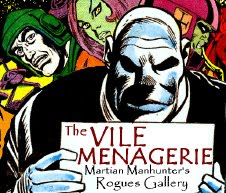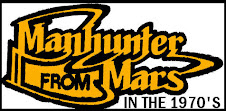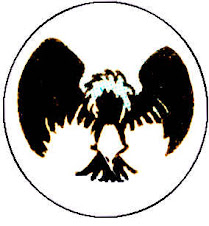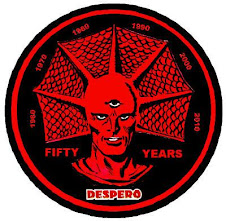
At this point, I'm just going to proclaim Tom Hartley a contributor to the blog. Through his initiative, we have the front cover, the back cover, the table of contents and now an introduction to the fictional DC Comics Martian Manhunter Archive Edition.
I was too lazy to write four whole pages, so most of the intro's first two pages are stolen from Bob Greenberger's text piece from the 2001 Millennium Edition reprint of Detective 225 and Mark Waid's text piece from the 1992 Silver Age Classics reprint. Pages 3 and 4 are all mine.
I believe I've read and quoted at least one, if not both, of those sources. I don't think either is in my possession anymore though, so I can't check to see where one ends and another begins. Instead, I'll just enjoy the combination of Greenberger, Waid, and especially Hartley as the pseudonymous gestalt entity "Wade Greenberg." The full text and images can be downloaded as a PDF, but I figured I'd post the straight text here as well...
He came from our neighboring planet, prominent brow and green skin clearly marking him as something other than human. At the height of an age in which aliens were usually seen as the enemy, he was a hero. And despite the fact that the Martian Manhunter has rarely been more than a supporting player in the DC Universe, he has shown surprising longevity, outlasting virtually every other science-fiction-based hero in comics.
The enduring heroes are the ones who are products of their time. Superman, protector of the weak and oppressed, was conceived during the great depression, when the American spirit was at its lowest ebb and people longed desperately to embrace a symbol of justice. Batman, the righteous vigilante, was birthed by the feelings of helplessness within the common folk, who were faced with the reality of urban crime when the industrial revolution created dark, crowded streets around them.
By the mid-1950s, America had been tempered by its victory in World War II, and postwar America was bustling toward a brighter tomorrow: the rapidly developing technology of atomic weapons, jet aircraft, computing machines and television allowed people to feel that a fantastic future might be just around the corner. People throughout the country entertained a new prosperity … and a weird, paranoid fear that someone was going to take it away from them. Senator Joe McCarthy had everyone believing that “evil Communists” skulked around every corner, posing as normal Americans while threatening our moral fibre. Likewise, science-fiction movie makers ran with that paranoia and used it to fuel films like INVASION OF THE BODY SNATCHERS and I MARRIED A MONSTER FROM OUTER SPACE, which enforced a “Keep Watching the Skies” mentality and personified the “enemy” as an Alien Threat. The message was clear: your life could easily be touched by aliens from that stellar infinity known (redundantly) as “outer space”. That nice, new neighbor couple down the block … that remarkably clean-cut young man your daughter married just last week … anyone.
Little green men from Mars walked among us, undetected. They could be barbers, politicians, insurance salesmen … or, in DC’s case, a police detective.
DC Comics, then known by the more staid company name, National Periodical Publications, capitalized on the rising popularity of science fiction in 1950 by launching STRANGE ADVENTURES. The success of this title prompted the arrival of MYSTERY IN SPACE in 1951, and DC provided a steady diet of stellar fare for the next twenty years. Over the course of their runs, these titles featured a variety of spacefaring characters including Chris KL-99 and Captain Comet. But the one who most sparked readers’ imaginations appeared in an unlikely place: DETECTIVE COMICS.
True to its name, DETECTIVE COMICS focused on the adventures of criminal investigators. In the 1950s, Batman, the lead feature, was backed by plainclothes detectives, each with his own gimmick: Roy Raymond, who debunked mysteries on that newfangled device, the television; Mysto, who used stage magic to solve cases; and Captain Compass, who kept the seas safe from modern-day pirates. So why not a detective who was secretly a Martian?
The idea of a lawman from Mars had been previously tried out in BATMAN #78 (August-September, 1953). In “The Manhunter from Mars”, the green-skinned Roh Kar aids the Dynamic Duo in capturing Quork, a “distorted genius” who uses his advanced Martian technology to embark on a crime-spree on Earth. Our heroes are able to defeat Quork by taking advantage of a weakness common to all Martians. Borrowing from H. G. Wells, writer Edmond Hamilton (who had himself written prose science fiction before turning to comics) reveals that something common on Earth and harmless to human beings proves to be a threat to Martians. In THE WAR OF THE WORLDS it was the common cold; for Hamilton’s Martians, it’s Earth’s oxygen-rich atmosphere, which induces “oxygen-intoxication”, rendering Quork too slaphappy to put up a fight. Roh Kar and Quork return to Mars, and that’s the last Batman and Robin, or anyone else on Earth, ever see of them.
But the idea resurfaced two years later, in 1955. DETECTIVE COMICS #225 saw the debut of a brand new back-up feature, “John Jones, Manhunter from Mars”, courtesy of veteran writer Joe Samachson and atmospheric artist Joe Certa.
Some may find a resemblance between Detective John Jones (whose true, Martian name is J’Onn J’Onzz) and DC’s more famous strange visitor from another planet with powers and abilities far beyond those of normal men, but unlike the Man of Steel, who collected accolades by using his powers openly and freely, Jones was forced by his otherworldly appearance to work in secret, performing his deeds invisibly rather than risk exposing himself to a distrusting world.
Both came from worlds with civilizations far in advance of our own——in J’Onn J’Onzz’s debut story we learn that there has been no war or crime on Mars for centuries——but unlike Krypton, Mars had not been destroyed by “unstable elements in its core”. J’Onn’s family and friends were still alive and awaited his return. However, J’Onn did not possess Superman’s powers of flight and super-speed (at least, not in the early stories). He was dependant upon technology to return to Mars. But the technology that had brought him to Earth——Dr. Erdel’s “robot brain”——had done so by accident. Erdel himself was only beginning to understand his complex new invention, and the reprogramming necessary to return J’Onn to Mars might take months or even years. And as luck would have it, the elderly inventor was so startled by the sudden appearance of a Martian in his laboratory, and by a demonstration of the Martian’s shapeshifting power, that he died of a heart attack. Meanwhile, J’Onn’s fellow Martians were still in the process of developing their own space program, Project Star-Ride, which might be years or even centuries away from fruition. J’Onn J’Onzz was stranded, as much a stranger in a strange land as the Martian hero of Robert Heinlein’s novel, and whenever he gazed into the night sky, he could make out his own world shining among the stars, it’s faint red glow beckoning to him.
While interplanetary travel was beyond his powers, he still possessed an impressive, and ever growing, set of abilities. In the first story he can read minds, change shape, become invisible and intangible, and use “mind over matter”, presumably a form of telekinesis, to extract gold from the ocean’s floor. The second story reveals that he has x-ray vision and that he can see into the future. We also see further examples of telekinesis, alternately called “Martian molecular hypnosis” and “Martian mind-over-matter”. He can fly in the third story, but presumably not fast enough or for a long enough duration to return to Mars. In the fourth story he withstands a ray blast that would have killed an Earthling. In the fifth story he has super-breath, in the sixth he has super-hearing, and so on. Obviously the writers were just making up new powers on the spot, giving our hero whatever fantastic ability was necessary to deal with a given situation. Suppose Det. Jones is at the city pier, and he finds out an armored car has just been stolen downtown. How does he immediately get downtown to stop whatever mischief is brewing? Nothing a little Martian will-power can’t solve. Through deep concentration he can will his body to any part of the world. Concentrate, Det. Jones. Concentrate on downtown … downtown … downtown … Some of these powers, such as the aforementioned ability to see into the future or teleportation as an application of will-power, or my personal favorite in his arsenal of vision powers, “Martian angle-vision”, which allowed him to see around corners, were only used once and then presumably forgotten by the writers. But most became a permanent part of his super-skill set, and by the later stories in this volume, he has many of the same powers as Superman, including flight, super-strength, near-invulnerability, assorted vision powers, super-hearing, and so on.
With all these powers, there has to be a weakness, of course, and J’Onn’s life would have been a lot easier if that weakness were something as exotic as Kryptonite. But, alas, the one weakness of all Martians is fire——not as common as oxygen, but still a nuisance. A Martian’s vulnerability goes beyond getting burned; proximity to fire drains a Martian’s strength, robs him of his super-powers, paralyses him, and ultimately kills him. Actually, the fear that overtakes J’Onn at the mere sight of fire is almost as debilitating as the physical effects. As with his other vulnerabilities, his homesickness and his alienation from those around him, having a phobia that plagued many real-world human beings was supposed to make him more sympathetic to readers. But the writers overdid it. Does every story have to show him cringing every time somebody lights a match? Must every other plot hinge upon his overcoming his fear of fire to save the day? Every pop culture icon needs a catch-phrase: “Truth, justice and the American way.” “Go ahead, make my day.” “Who knows what evil lurks in the hearts of men?” “It’s clobberin’ time!” For poor J’Onn it’s, “Fire! My one weakness!”
This volume collects the first three years of “John Jones Manhunter from Mars” back-up stories in DETECTIVE COMICS, from issues #225-260 (1955-58), and shows the series concept evolving from plainclothes detective with a gimmick (our hero is secretly a Martian) to super-hero action-adventure. In the early stories we rarely see Det. Jones in his Martian form——never at all, in many stories. But beginning in “The Hero Maker” in issue #240 (February, 1957), he assumes his Martian form whenever he uses his powers. The last story in which we never see him as the Martian Manhunter is issue #249’s “Target for a Day” (November, 1957), and ironically, we see very little of Detective Jones either; he spends most of the story disguised as the Governor (of an unnamed state, of course). Gradually the stories become more about a super-powered being from Mars and less about a police detective with an otherworldly secret. By the end of this volume J’Onn J’Onzz still hasn’t revealed his existence to the world (that will come in volume 2), so it is only we readers who see more and more of the Martian Manhunter. Whenever he assumes his true form he has to become invisible. And it only makes sense that as the stories become more “super-hero-ey” the menaces become more fantastic, with mobsters, con-artists and arsonists(!) giving way to mad scientists, paramilitary gangs equipped with tanks and jet fighters, and even other Martians. (Alas, even Mars couldn’t remain crime-free forever.)
To reflect the change in the stories, artist Joe Certa’s visual style becomes less detailed and atmospheric, and more economical and light-hearted, more “cartoony”. His depiction of the Martian Manhunter also changes. The brow gradually becomes less prominent and eventually disappears altogether, as does the overbite. He develops a pugilist’s square jaw and broad pug nose. But as we will see in later volumes, the nose will become straighter and narrower, and the jut of his jaw a bit less pronounced, making him more conventionally handsome. It must have been felt that making the hero more human in appearance would make him more appealing to readers, and maybe it did at the time——the feature must have been popular to have lasted so long. But for me, as his appearance becomes less alien, he loses some of his charm. (Fortunately, in the late ‘70s artist Michael Netzer would restore J’Onn’s alien visage, brow and all, in a short-lived series of back-up stories in ADVENTURE COMICS.)
J’Onn’s run in DECTECTIVE COMICS eventually ended, after 102 issues, in #326 (April, 1964), making it one of the longest running back-up features in the book’s history. When editor Julius Schwartz took over from the departing Jack Schiff, he replaced the Manhunter from Mars with a new back-up feature, the Elongated Man. Schiff, meanwhile, took over HOUSE OF MYSTERY beginning with issue #143 and took the Manhunter with him.
But we don’t want to get ahead of ourselves——and we don’t want this introduction to take up the entire book. On with the stories!
—— Wade Greenberg
WADE GREENBERG was born in Middleton, Colorado, and currently lives in Apex City with his faithful canine companion, Zook. He is the author of numerous books, including his latest, Better a Red Planet than a Dead Planet.






























3 comments:
Thanks for posting these. I'll need your help with Vol. 2. Please check your Yahoo! inbox.
Here's a color-coded version, revealing who wrote what. Green is Greenberger, red is Waid and black is me:
http://home.nethere.net/tomhartley/mmarchives1introcc.doc
I loved that fact that you're from Middleton. Or is it Apex?
Vol. 2:
http://home.nethere.net/tomhartley/mmarchives2.jpg
Post a Comment